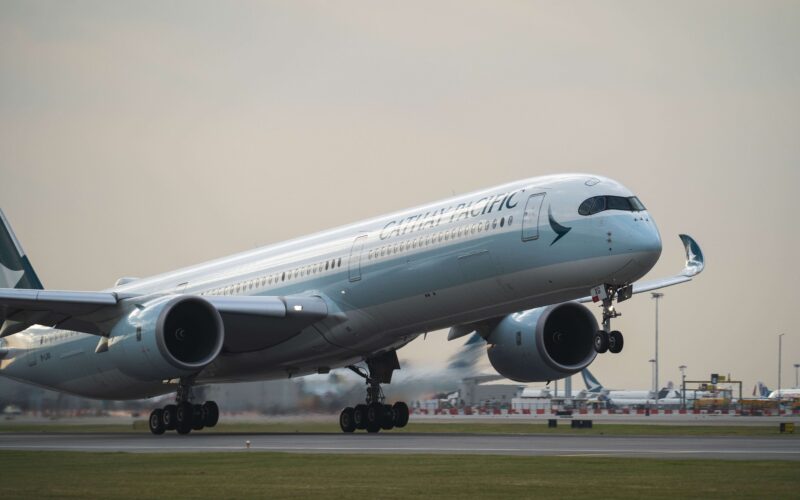Dating back to the 1940s, Hong Kong’s flag carrier Cathay Pacific has operated more than eight decades as one of the most recognizable East Asian full service carriers (FSC).
However, Cathay Pacific was among the airlines worst affected by the COVID-19 pandemic. Since the beginning of the global health crisis, which saw a significant reduction in the demand for air travel, Cathay Pacific has been reporting losses.
So, what does the future hold for Cathay Pacific post-pandemic?
A turbulent period during COVID-19
Since the onset of the COVID-19 pandemic in 2020, Cathay Pacific has posted a record loss of HK$21.6 billion ($2.8 billion), a significant decrease compared to HK$1.7 billion ($218 million) net profit in 2019. The net loss was attributed to a dramatic decrease in international passenger traffic and travel restrictions.
In a bid to reduce costs, Cathay Pacific initiated financial restructuring in October 2020. As a result, its subsidiary Cathay Dragon ceased operations. The airline also laid off approximately 8,500 employees, initiated a hiring freeze, cut executive wages, and asked staff to take part in two voluntary leave schemes.
According to Cathay Pacific, restructuring saved the airline HK$500 million ($64 million) per month.
Additionally, Cathay Pacific decided to defer deliveries of ordered aircraft, which helped the airline to save billions of dollars. According to data released in March 2021, the airline made an agreement with Airbus to defer Airbus A350 aircraft delivery dates from 2020 to 2023. Currently, Airbus orders and deliveries data shows that Cathay Pacific has only three A350-1000s on order.
In April 2021, the South China Morning Post reported that Cathay Pacific would downsize its Boeing 777-9X aircraft order from 21 aircraft to between 10 and 15 airplanes. However, in a statement given to AeroTime News, a Cathay Pacific spokesperson said that the airline was in “advanced negotiations” to defer its 21 Boeing 777X aircraft order without mentioning plans to downsize.
In the first half of 2021, Cathay Pacific closed several foreign pilot bases due to the continuous decrease in passenger traffic levels. In April 2021, Cathay Pacific also closed its pilot base in Canada. Further closures followed in Australia, New Zealand, and Germany. Cathay Pacific is still reviewing its North American pilot bases.
The British base is the latest to face closure. But the decision to close the pilot base in London was not “taken lightly and it does not reflect on the professionalism of the pilots,” Cathay Pacific told AeroTime News in an emailed statement on September 10, 2021.
However, in the first half of 2021, the airline reduced its net loss to HK$7.5 billion ($963 million) from HK$9.9 billion ($1.3 billion) during the same period in 2020.
Cathay Pacific revealed it was able to reduce losses by approximately a quarter owing to cost-cutting measures and a strong air cargo demand. According to the airline, air cargo alone accounts for 80% of the airline’s revenue generated during the past months.
In the company’s financial report, Patrick Healy, chairman of Cathay Pacific, said: “COVID-19 continued to pose significant challenges for the Cathay Group in the first half of 2021, and this continues to be the toughest period in our history.”
What’s ahead?
Cathay Pacific, which does not operate a domestic market, is expected to recover when international air traffic increases.
However, in August 2021, independent aviation analyst Brendan Sobie told AeroTime that the Asia-Pacific region is likely to be the last market segment to recover from the debilitating impacts of the pandemic.
In a press release dated August 26, 2021, Subhas Menon, Association of Asia-Pacific Airlines (AAPA) Director General, said: “The outlook for air travel is dependent on further progress with vaccinations across Asia and globally. Crucially, greater collaboration amongst governments on harmonised cross-border measures is necessary, in line with ICAO and WHO recommendations.”
According to International Air Transport Association (IATA) estimates made in July 2020, the global passenger traffic will not return to pre-COVID levels until 2024. However, IATA anticipates that travel will recover to 43% of 2019 levels in 2021.
Recent data shows that Cathay Pacific carried a total of 135,353 passengers in August 2021, which is an increase of 278.4% compared to August 2020, but a 95.3% decrease compared to August 2019.
Cathay Pacific had hoped to fly 30% of its pre-COVID capacity by the end of 2021. However, the airline announced that throughout 2021 capacity will be maintained at a similar level to August, when it operated just 13% of its usual activity.
“Operational and passenger travel restrictions remain in place, continuing to constrain our ability to operate more flights,” Ronald Lam, chief customer and commercial officer at Cathay Pacific, announced in a statement dated September 20, 2021.
Lam continued: “As such, we now only expect to maintain similar passenger capacity levels to August 2021 for the remainder of the year, while remaining responsive to any unexpected changes in travel restrictions.”
For the remainder of 2021, Cathay aims to keep its cash burn rate below HK$1 billion ($128 million) per month.
According to Cathay Pacific, air cargo demand is likely to continue to drive the airline’s revenue “as the market indicators suggest a strong peak season driven by the need for inventory replenishment”. In August 2021, the airline welcomed two additional Boeing 777 “preighters”, taking its total to six and providing the airline with more cargo capacity.
Lam added: “Despite our short-term challenges, we remain committed to keeping our home city connected to the world via the Hong Kong international aviation and logistics hub.”

